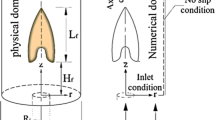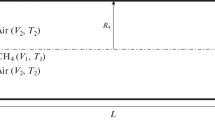Abstract
The fuel and oxidiser react as soon as they mix in a non-premixed flame, and the rate of combustion is restricted by the mixing. To improve mixing in such kinds of combustion, a high turbulence shear layer in the combustion system is preferred. By assisting in the fuel–air mixing process and providing a recirculation region that can act as flame holders and impact residence time, air swirling can control combustor performance. ANSYS will be used to do numerical analysis for the conditions mentioned above. The turbulence model used in this work is k-epsilon, which has been shown to be reliable in similar experiments. Fluent has a number of pressure-based algorithms. For velocity and pressure coupling, a SIMPLE method was used in this work. With two-equation turbulence models, the first-order upwind technique has been applied. The interaction between turbulence chemistry and non-premixed combustion was modelled using the (PDF). The thermal properties and flow velocity were displayed across the axial positions of the burner at varied regulating parameters.
Access this chapter
Tax calculation will be finalised at checkout
Purchases are for personal use only
Similar content being viewed by others
Abbreviations
- AFR:
-
Air–fuel ratio
- CFD:
-
Computational fluid dynamics
- CTRZ:
-
Central toroidal recirculation zone
- PDF:
-
Probability density function
- \(\emptyset\) :
-
Equivalence ratio
- \(f\) :
-
Mixture fraction
- R:
-
Radius
- SN:
-
Swirl number
References
Karyeyen S, Feser JS, Gupta AK (2019) Swirl assisted distributed combustion behaviour using hydrogen-rich gaseous fuels. Appl Energy 251(5)
Kumaran K, Shet USP (2007) Effect of swirl on lean flame limits of pilot-stabilized open premixed turbulent flames. Combust Flame 151:391–395
Huang Y, Yang V (2005) Effect of swirl on combustion dynamics in a lean-premixed swirl-stabilized combustor. Proc Combust Inst 30:1775–1782
Raj RTK, Ganesan V (2008) Study on the effect of various parameters on flow development behind vane swirlers. Int J Therm Sci 47:1204–1225
Kim MY (2012) Effect of swirl on gas-fired combustion behaviour in a 3-D rectangular combustion chamber. World Acad Sci, Eng Technol 6
Hashemi SA, Fattahi A, Sheikhzadeh GA, Mehrabian MA (2011) Investigation of the effect of air turbulence intensity on Knox emission in non-premixed hydrogen and hydrogen-hydrocarbon composite fuel combustion. Int J Hydrogen Energy 36:10159–10168
Syred N, Beer JM (1974) Combustion in swirling flows: a review. Combust Flame 23:143–201
Hosseini AA, Ghodrat M, Moghiman M, Pourhoseini SH (2020) Numerical study of inlet air swirl intensity effect of a Methane-air diffusion flame on its combustion characteristics. Case Stud Therm Eng 18(2):100610
Wang LY, Chatterjee S, An Q, Steinberg AM, Gülder ÖL (2019) Soot formation and flame structure in swirl-stabilized turbulent non-premixed methane combustion. Combust Flame 209:303–312
Wang K, Li F, Zou P, Lin X, Mao R, Yu X (2019) Effect of the fuel-air flow velocity on heat release rate of swirling non-premixed methane flames. Aerosp Sci Technol 95:105465
Acknowledgements
We are thankful to Mr. Piyuh Savaj, for his help during this work. This work was supported by the S. V. National Institute of Technology Surat [Grant Code No. 2020-21/Seed Money/13].
Author information
Authors and Affiliations
Corresponding author
Editor information
Editors and Affiliations
Rights and permissions
Copyright information
© 2023 The Author(s), under exclusive license to Springer Nature Singapore Pte Ltd.
About this chapter
Cite this chapter
Kadia, K., Baraiya, N.A., Shah, R.D. (2023). Numerical Investigation on Characteristics of Methane Combustion. In: Mehta, H.B., Rathod, M.K., Abiev, R., Arıcı, M. (eds) Recent Advances in Thermal Sciences and Engineering. Lecture Notes in Mechanical Engineering. Springer, Singapore. https://doi.org/10.1007/978-981-19-7214-0_27
Download citation
DOI: https://doi.org/10.1007/978-981-19-7214-0_27
Published:
Publisher Name: Springer, Singapore
Print ISBN: 978-981-19-7213-3
Online ISBN: 978-981-19-7214-0
eBook Packages: EngineeringEngineering (R0)




